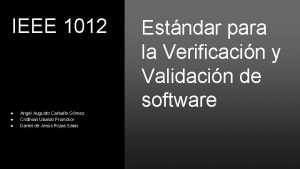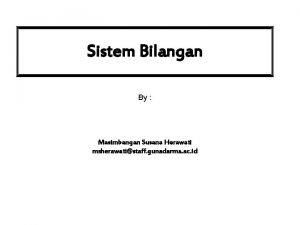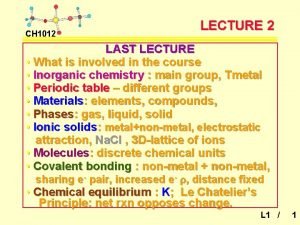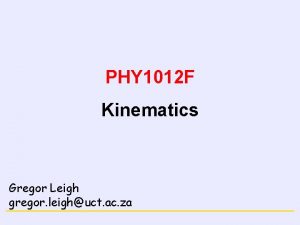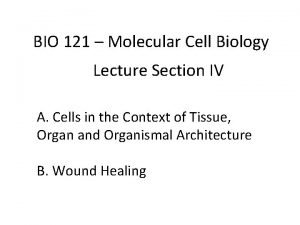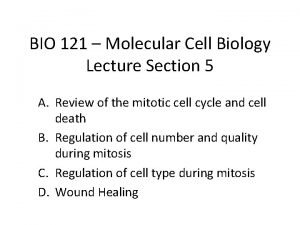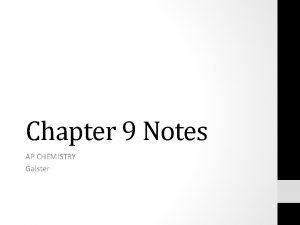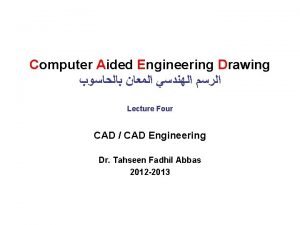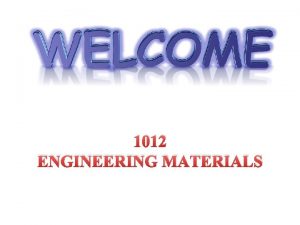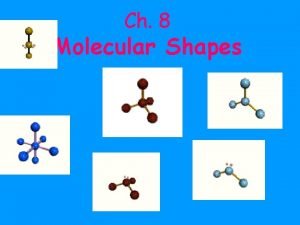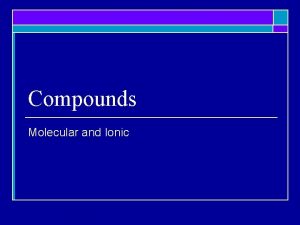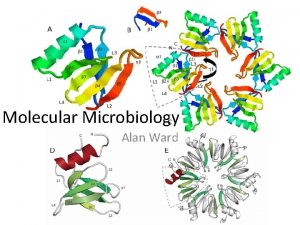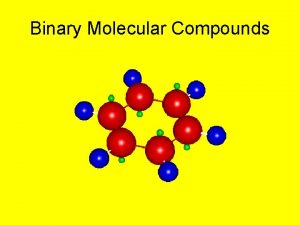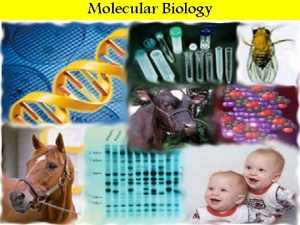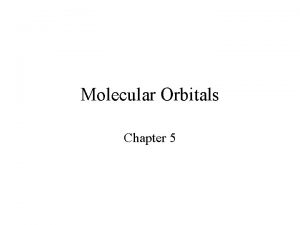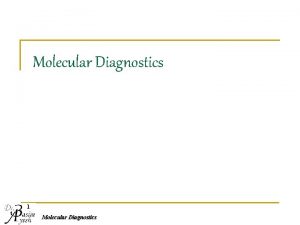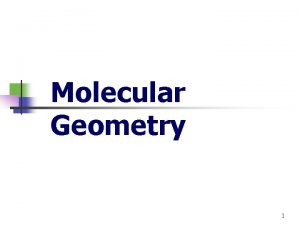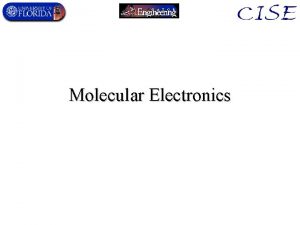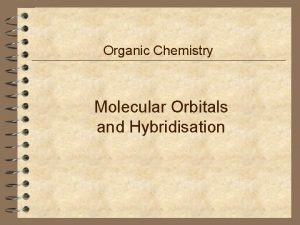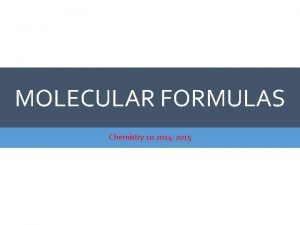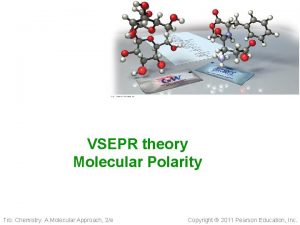CH 1012 LECTURE 1 CH 1012 MOLECULAR CHEMISTRY


















- Slides: 18

CH 1012 LECTURE 1 CH 1012 MOLECULAR CHEMISTRY · 12 Modules (Learn. JCU CH 1012) Computer Labs 20 hr access • Lectures: 33 (+ 2 revision) • Tests: 2 Tutorials: 10 • Practicals: 9 Room E 1. 113 • Mike Liddell Room E 1. 102 B 12 -1 pm • Ph: 4042 1275 michael. liddell@jcu. edu. au • WEB : http: //learnjcu. edu. au • Notices : Learn-JCU • Module lockups: robert. thomas@jcu. edu. au L 1 / 1

CH 1012 WHAT IS TO COME - CH 1012 • Inorganic: Periodicity groups 1 A - 4 A, coordination chemistry, stereochemistry, ligands, macrocycles, crystal field theory. • Physical: Phase equilibria (distillation), colloids & properties, molecular orbital theory, spectroscopy, metallurgy, new materials (alloys, ceramics, polymers). • Organic: Purification and characterisation of organic compounds. IR, UV/Vis and NMR Spectroscopy. Common reaction types radical, SN 1, SN 2, addition, elimination … Reactions of alkanes, alkenes, aromatics, aldehydes, ketones, and carboxylic acids. L 1 / 2

CH 1012 ASSESSMENT • Examination (2 hr. ) June 42% • Laboratory (3 hr. x 9 wks. ) 20% - attendance > 80% required to pass - medical cert. needed if absent • Tutorials & Tests (1 hr. x 11 wks. ) 33% - 2 x tests (calculator) = 28% • Learn. JCU Modules (12) 5% - complete each with a total mark > 50% required to pass • Invigilated components : The final exam and test dates are fixed. You cannot sit at another time (unless medically ill etc) N. B. flying somewhere is not an excuse. 3

CH 1012 PURCHASES • Texts: • 1) Brown, Le May, Bursten: Chemistry. 10 e 2) Mc. Murray: Fund. of Organic Chemistry + Harcourt Organic CD-ROM. 6 e 1) $ 121 2) $114 • • Faculty Office CH 1012 Lecture Notes CH 1012 Laboratory Notes CH 1012 Report Book CH 1012 Book of Readings » $ 18 $5 $4 $3 • Pay at the Cashier in A 1 and collect your books from the faculty office E 1. 102 N. *Book of Readings printed after Week 1. 4

CH 1012 LABORATORY PURCHASES • Laboratory Breakage Deposit Fac. office = $ 20 Bring your receipt to the first practical Most of it is refunded ($2 labcoat isn’t) Refunds must be collected < 4 weeks after week 13 of the semester. • Laboratory coat Provided • Safety glasses Provided • Footwear No sandals or thongs or barefeet. 5

CH 1012 COURSE CONTENT • Lectures: The main means of introducing material. A lot of areas are only covered in the lectures and so you will need to attend. • Learn. JCU modules: Computer learning & assessment is used in CH 1012. The quiz pages in the modules are assessed. By completing all of them and having a total score >50% you get your 5% assessment. • Tutorials / Tests: to give you some feedback on how you are going. • Practicals: relevant experimentation. • Reading: you need to read around what is in the lectures and modules to do well. L 1 / 6

CH 1012 RESERVE AND MODULES Closed Reserve in the Library: • Copies of Brown, Le May, Bursten and Mc. Murray. • Copies of Brown-Le May Partial Solutions guide & Mc. Murray Study guide which give worked answers & further study practice. It is expected you find these Solutions guides and get used to using them. • Book of Readings. Module lock-ups: e-mail robert. thomas@jcu. edu. au - let him know specifically the Module and screen that is involved (eg. M 1/P 5). L 1 / 7

CH 1012 INORGANIC CHEMISTRY Inorganic chemistry – the chemistry of compounds that are not organic in nature. (Organic compounds have C as the basic structural element & do not contain metals. ) • Inorganic chemistry is generally split up into the following divisions: 1) Main group chemistry 2) Transition metal chemistry 3) Lanthanide-actinide chemistry We will look at divisions 1) & 2), and a general sub-grouping called organometallic chemistry. L 1 / 8

CH 1012 THE PERIODIC TABLE INORGANIC Alkali Metals Main group Alkaline Earth Metals ORGANIC Transition metals 9

CH 1012 MATERIALS Types of material Element: C(s) - pure, one atom type graphite, diamond, C 60 allotropes - different forms • not a common form for most elements • Noble gases, N 2, O 2, S 8, Cu, Ag, Au, Pt Compound: C 2 H 6 O 1 - pure, >one atom type eg. Si. O 2, Al(OH)3, Fe 2 O 3 isomers • the most common form of most elements • pure elements and compounds are present as distinct phases and are held together by specific types of bonding. 10

CH 1012 PHASES Phases (states of matter) Gas - particles are very mobile (km / s) - large average interparticle distance - fills container, no surface, low r eg. H 2 = homonuclear diatomic Liquid - particles are mobile (mm / s) - small interparticle distance - fills container, forms a surface Solid - particles non mobile and in contact - fixed shape, high r Amorphous - Si. O 2 - glass Crystalline - Si. O 2 - quartz 11

CH 1012 IONIC SOLIDS • Ionic solid: no discrete molecular units rather a 3 -D lattice of cations(+), anions(-) in a fixed arrangement. eg. Na Cl • Strong electrostatic attraction between each ion and neighbouring oppositely charged ions Na+ holds the solid together. This attraction is Cltermed ionic bonding. • Ionic bonding is common between elements on the LHS & RHS of the periodic table, ie. metal + non-metal L 1 / 12

MOLECULES CH 1012 • Molecule : a distinct chemical unit which contains 2 or more covalently bound atoms. eg. H 2 O(l) : may be elements or compounds. eg. H 2(g) , H 2 O(l) : gases, liquids or solids. Glass surface eg. H 2 O(g) , H 2 O(l), H 2 O(s) ice : open hexagonal structure Snow crystals H 2 O surface L 1 / 13

CH 1012 COVALENT BOND Covalent bonding - non-metal + non-metal • sharing e- pair(s) between atoms so that the resulting molecule is more stable than the eg. Cl 2 constituent atoms A covalent bond = a physically observable constant interatomic distance and increased interatomic electron density. eg. Cl-Cl Å (Å = 10 -10 m) 14

CH 1012 EQUILIBRIUM Chemical Equilibrium and Kc Kinetics kf a. A + b. B ® ¬ c. C At Equilibrium: kr • the amounts of reactants / products do not change with time. k • rate of forward & back reaction are equal Kc = [product C]c [reactant A]a [reactant B]b • a, b, c are from the balanced equation • Kc is the equilibrium constant which tells us the extent of reaction at completion. Kc 15

CH 1012 LE CHATELIER Le Chatelier's principle When a chemical system at equilibrium is disturbed then it regains equilibrium by undergoing a net reaction that reduces the effect of the disturbance to try to restore K. a. A + b B ® ¬ c. C + d D • addition of reactant A to the LHS promotes the forward reaction LHS ® RHS • addition of product C to the RHS promotes the reverse reaction LHS ¬ RHS 16

CH 1012 • • • FOR THIS WEEK You will need to complete the first module Make as many purchases as you can. Class representative ? 17

CH 1012 WORK AHEAD • Module to Cover this week 1. Bonding, Equilibria and Colloids Related sections in text Brown/Lemay/Bursten A. Intro to Chemistry, Atoms, Periodic Table P 1 - 7 , 49 -52 B. Units & Significant figures, conversions P 14 - 29 C. Atomic structure P 43 - 46, 224 -238 D. Molecules, Compounds, Ionic Cmpds P 52 - 60 E. “Lewis Dot” Formulations P 302, 310 F. Bonding and Ionic compounds P 303 – 305 G. Colloids P 558 – 563 H. Equilibrium P 629 - 631 I. Equilibrium constant K P 632 - 634 J. Le Chatelier’s principle P 649 - 654 K. Kp, Kc calculations P 643 – 645 * See also Book of Readings, Everett for extra material on Colloids. 18
 1012 angel
1012 angel Komplemen 9 dari 458 =
Komplemen 9 dari 458 = Uhmt
Uhmt Ch 1012
Ch 1012 1012
1012 01:640:244 lecture notes - lecture 15: plat, idah, farad
01:640:244 lecture notes - lecture 15: plat, idah, farad Cell and molecular biology lectures
Cell and molecular biology lectures Enteroendocrine cell
Enteroendocrine cell Diapedesis
Diapedesis Physical state of covalent compounds
Physical state of covalent compounds Giant molecular structure vs simple molecular structure
Giant molecular structure vs simple molecular structure Zinc oxide + nitric acid → zinc nitrate + water
Zinc oxide + nitric acid → zinc nitrate + water Advanced inorganic chemistry lecture notes
Advanced inorganic chemistry lecture notes Lightning elves
Lightning elves Ap chemistry unit 9 notes
Ap chemistry unit 9 notes Democritus atomic model diagram
Democritus atomic model diagram Inorganic vs organic chemistry
Inorganic vs organic chemistry Ib chemistry functional groups
Ib chemistry functional groups Drawing lecture
Drawing lecture
